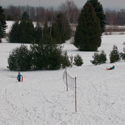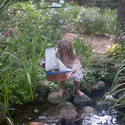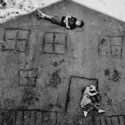A few days ago we went over to the Georgia Street Garden on the city's East Side and a really nice group of kids from that neighborhood came out and helped us make a few hundred seed bombs as part of a small project to beautify Detroit. On its surface, this neighborhood is pretty typical of the city. It isn't shockingly empty like some of the more dramatic areas nearby, but you'll find no shortage of burnt-out shells of houses, or vacant lots where houses once stood. But to focus on those would be to ignore the reality that this neighborhood is not abandoned. Plenty of good people live in this neighborhood; plenty of the houses are well-maintained with proud lawns by proud people. There is new infill housing. There are churches and schools. But the most striking thing about this neighborhood are the gardens. Over the three years I've been coming here, I've seen more and more gardens popping up, some well away from the central community garden started by neighborhood hero Mark Covington back in 2007-8 (I first wrote about him here). Smaller vacant lots are getting transformed into new gardens, and more backyards are being tilled this year than last. The rooster's cry vies with that of the alley pheasant.
Still, despite the good that the gardens bring, it's a tough neighborhood, particularly at its edges. There's no getting around that fact. Like so many other neighborhoods in this city, the residents of the Georgia Street neighborhood must contend with the everyday realities that crushing poverty brings. I don't want to sugarcoat this post with any nonsense about how coming to this neighborhood for an afternoon and making wildflower seed bombs would do anything about the crime, or the lack of jobs and opportunities that these kids face. I didn't do this to "help" these kids; I really went there hoping they could help me and my children better understand the city we're living in, outside of the natural bubble we've created for ourselves downtown. I want to stress that I am not writing this today in search of any recognition for my humble efforts, but because I want you to see for yourselves how cool these kids are, and give you a vision of the city of Detroit as something more than ruins, prairies, and vine-covered houses.
My daughter, a veteran of the seed bomb manufacturing process, stood by my side as I explained the basics. I could tell she was proud of already knowing what to do, and wanted to help show everyone the process. She's usually so shy, and I was pretty proud of her for jumping right in there among the big kids to get her hands dirty.
I was hoping to make 1000 little seed bombs, but the kids developed their own technique of making bombs the size of baseballs filled and covered with native Michigan wildflower seeds. They were like neutron seed bombs. I also brought some peat cups to plant sunflower (and other) seeds in, with the idea that they could be stuffed in the cracks of broken porches or hulks of burned and abandoned homes. It didn't take long for the huge board we would use to dry the bombs to start filling up, or for my reserves of soil, peat, and clay to start running out (and I'd like to thank the anonymous Sweet Juniper reader who sent a $20 bill to Busy Bee Hardware to help fund this project).
Once the board was full and the supplies were dwindling, the kids were ready to clean off their hands and get started learning how to work the cameras I brought for them. As I briefly mentioned in this post, I have been meaning to get some cameras in the hands of a few Detroit kids in order to document their own lives (I know this is hardly an original concept, but I wanted to do it my own way). I wanted to give the kids cameras with no strings attached, but still offer them my services to help them develop, digitally edit, and publish their work online and display their printed work. After writing about it, I received dozens of offers for working digital cameras and for a few days our mailbox was flooded with them. I received so many that I was able to take the money I had set aside for cameras and use it to buy extra digital media cards, film, batteries, and an identical carrying case for each kid. Thanks to all these generous Sweet Juniper readers, there were some really excited kids on Georgia Street that evening. The kid in the middle of this picture, Benito, looked up at me and quietly said, "You mean, this camera is mine? Like, until I die?"
After the initial excitement wore off, the kids sat down with a book I'd made of many of the photos that I've taken in this city. It was pretty interesting for me, to suddenly see my photographs through their eyes. Occasionally Mark would point to something and tell them where in the city the subject was; when they saw this photo one of them said, "Hey, that's Tippy-Toe Ty! He's always asking for a dollar." When I admitted to giving him a few, the kid replied, "See, now that only encourages him." When Mark saw the first photo in this post he laughed, "I know that dog. My wife named him. Zeus." The things they knew about my own photos confirmed to me the reason I wanted to give them cameras. I hoped they would help them tell their own stories in a way I never could.
My wife finally swung by with a car full of pizzas, and when she got out she said one of the kids ran up to her and breathlessly reported, "We're getting our hands muddy on purpose! And some guy over there gave me a camera!" before running away. He didn't even know about the pizzas yet. The pizzas from Supino were a big hit among the seed bomb makers, and my son proved bold enough to get the first slice (even though he spent most of the evening hitting raised vegetable beds with sticks held in his muddy hands). Two-year olds.
The Georgia Street Community Collective is so much more than a series of gardens that provide delicious and healthy food to the neighborhood every summer. The organization is essentially a counterattack against forces that have been besieging the neighborhood for decades. It shows how one good man in one neighborhood stood up to say "enough" only to discover how far from alone he actually was. The collective has made great strides in transforming an abandoned liquor store into a corner store for the neighborhood that will sell the sorts of things that the garden can't provide. Next door, the collective has secured and transformed an abandoned home it obtained for back taxes into a burgeoning community center. In these spaces, the community will continue to celebrate events like the annual Easter Egg Hunt, the school supplies giveaway (with free haircuts!), the reading and movie nights, the Super Bowl Party, holiday dinners, and all the other events that make this organization so inspiring. Eventually I hope to install some computers in the community center where the kids will be able to edit their own photos, but for now I'm just so excited to see how they document their summer in the garden and beyond.
At the end of the day, I was so grateful to Mark and these kids for spending some time with my family on this somewhat silly, mostly-symbolic project, and also grateful to our friend Meghan as well as Mitch, Gina, and Eva from the Powerhouse Project for helping out. I don't know if the seed bombs will produce any flowers, but I think everybody had a good time (which is all I really wanted). And who knows; maybe some of these seeds will produce something after all.
* * * * *
I'm still getting more cameras ready to give to a new batch of kids, and I hope to be able to share some of their work with you relatively soon. I do keep getting e-mails about more cameras and I think I'm all set for now. If you are interested in contributing something to the Georgia Street Community Collective, I'm going to be giving you a really unique opportunity to do so in a couple weeks. So stay tuned.








































